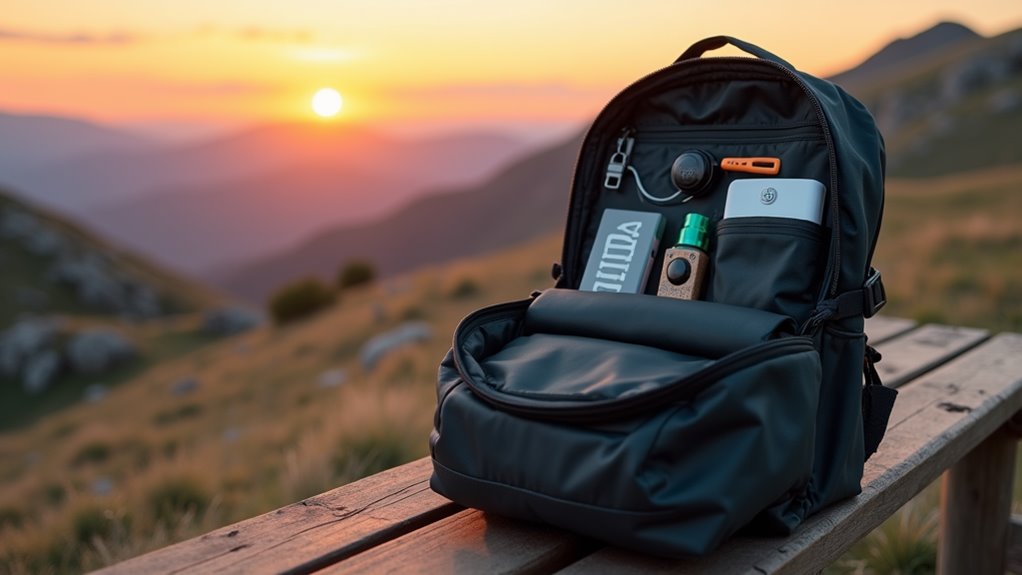Pack smart to stay safe on your solo adventures with essential items like a doorstop alarm, personal safety alarm, and portable charger for your devices. You’ll want to carry a first-aid kit, copies of important documents, and a small flashlight in your daypack. Keep valuables secure with an anti-theft bag and money belt, and bring a basic lock for hostel lockers. There’s much more to take into account when planning your safety strategy abroad.
Freedom to Explore Independently

When you’re traveling solo, you’ll have the incredible freedom to connect with locals exactly when and how you want to, whether that’s chatting with a shopkeeper or joining a guided walking tour.
You’re in complete control of your daily schedule, letting you linger at that fascinating museum or switch plans at a moment’s notice if something doesn’t feel right. It is important to consider discreet protection like the Fang Keychain Stun Gun, which comes with a 100-Lumen flashlight and is lightweight, making it easy to carry.
Through each independent decision and challenge you face, from managing public transit to solving unexpected problems, you’ll build valuable self-reliance skills that’ll serve you well beyond your journey.
For added personal safety, consider carrying a compact mini stun gun with you, which combines functionality with discreetness.
Meet Locals on Your Terms
Although meeting locals can enrich your solo travel experience, you’ll want to maintain control over these interactions to stay safe and comfortable.
When engaging in cultural exchange, trust your instincts and set clear boundaries about your time and personal space. You’ll find that most locals appreciate tourists who respect their customs and follow local etiquette.
Choose public places for meetups, like busy cafes or popular tourist spots, and let someone know where you’re going.
If you’re joining group activities or tours, stick with licensed guides and reputable organizations that other travelers have reviewed.
Don’t feel pressured to share personal details or accept invitations that make you uneasy, even if someone seems friendly.
Create Custom Daily Schedules
Since you’re traveling solo, creating a flexible daily schedule gives you complete control over your adventure while keeping safety in mind.
You’ll want to develop custom itineraries that balance spontaneity with smart time management, ensuring you’re not out too late in unfamiliar areas.
Map out your daily activities with specific timeframes, including buffer periods for unexpected discoveries or transportation delays.
Let your accommodation staff know your general plans for the day, and set check-in times with family back home.
When you’re planning activities, schedule high-risk areas like crowded markets or remote locations during daylight hours.
Remember to include dedicated rest periods to recharge and assess your surroundings.
If something doesn’t feel right about your planned route or timing, don’t hesitate to adjust your schedule on the fly.
Build Self-Reliance Through Challenges
Building self-reliance through solo travel will transform you into a more confident and capable explorer, ready to tackle unexpected situations head-on.
As you commence your self-discovery journey, you’ll develop essential problem-solving skills by traversing unfamiliar places, managing your own schedule, and making decisions independently.
Here’s what you’ll gain through embracing solo travel challenges:
- Enhanced adaptability when facing unexpected changes, like missed connections or language barriers
- Stronger decision-making abilities as you learn to trust your instincts and judgment
- Greater emotional resilience from successfully managing stressful situations on your own
Research Regional Safety Guidelines
Before setting foot in any new destination, you’ll need to thoroughly research that region’s specific safety concerns and guidelines. Start by learning about local cultural norms, including appropriate dress codes and behavior that won’t draw unwanted attention. Make sure you’ve got a list of emergency contacts, including your country’s embassy, local police stations, and nearby hospitals. Check travel advisories from your government’s website to understand current risks, such as political unrest or health concerns. You’ll want to research common scams that target tourists in your destination, and learn which neighborhoods to avoid, especially after dark. If you’re visiting during a local festival or major event, look up any special safety measures you should take, and always have a backup plan for getting around if your primary transportation option falls through. Consider carrying a compact personal alarm for quick activation in emergency situations, as it can be an effective deterrent and draw immediate attention if needed.
Check Government Travel Advisories

Government travel advisories serve as your primary line of defense when planning solo adventures abroad.
Before booking your trip, you’ll want to check official government guidelines for your destination country, as they’ll provide vital updates about local safety conditions, potential health risks, and current travel restrictions that could affect your journey.
You can easily access these advisories through your country’s foreign affairs website, where you’ll find color-coded warnings and detailed reports about specific regions.
Make sure you’re checking these resources regularly, even after you’ve made your travel arrangements, as safety conditions can change quickly.
It’s also smart to sign up for travel alerts from your government, which will notify you immediately about any emerging situations in your destination that could impact your safety.
Check Country-Specific Crime Data
While travel advisories provide a broad overview of safety concerns, diving into specific crime statistics for your destination can reveal essential patterns you’ll need to watch for during your trip.
You’ll want to research recent crime rates in different neighborhoods, particularly focusing on tourist areas and public transportation hubs where travelers often become targets.
Look up safety trends from the past few years to identify whether certain types of crimes, like pickpocketing or scams, are becoming more common in your destination.
Pay special attention to crime statistics during the season you’re planning to visit, as some areas experience higher crime rates during peak tourist months.
You can find this information through local police websites, tourism boards, and reputable travel forums where other solo travelers share their experiences.
Answers to Common Questions
What Essential Travel Documents Should I Carry While Traveling Solo?
You’ll need your passport, multiple copies stored separately, emergency contacts list, travel insurance documents, visa papers, and vaccination records. Keep digital copies in your email and physical copies with trusted contacts back home.
How Can I Protect My Valuables in Shared Accommodations?
Use the hostel’s secure storage lockers, don’t leave valuables unattended, and invest in a portable travel lock. Keep important items close while sleeping, and consider theft prevention tools like cable locks for your bags.
Which Travel Insurance Coverage Is Best for Solo Travelers?
Want peace of mind while exploring solo? You’ll need extensive coverage that includes emergency assistance, trip cancellation, medical evacuation, and lost baggage protection. Check policies that offer 24/7 support and adventure activity coverage.
What’s the Safest Way to Carry Money While Traveling Alone?
Keep your valuables secure by wearing a hidden money belt under your clothes. You’ll also want to use digital wallets and spread cash between multiple locations. Don’t carry everything in one place.
Should I Share My Real-Time Location With Family While Traveling Solo?
Just like your sister’s location sharing helped find her during that hiking emergency, you should enable it while traveling solo. Despite privacy concerns, it’s essential for safety – but limit access to trusted family members.
Bottom Line
When you’re exploring the world solo, you’ll want to keep your wits about you and stay one step ahead of potential risks. Make sure you’ve done your homework by researching safety guidelines, checking travel advisories, and understanding local crime patterns. With careful planning and the right safety essentials packed in your bag, you’re ready to embrace amazing adventures while keeping yourself out of harm’s way.




